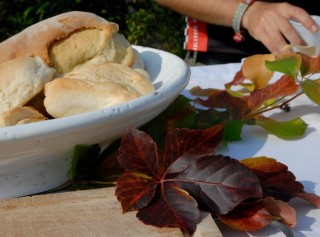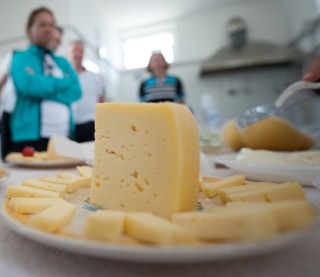 At The Slow Road we believe that getting in deep and up close has as much to do with a region’s culinary culture as it does with its geography and people. You can’t really call yourself a cultural adventurer if you don’t embrace the local delicacies. In our Cuisine 101 series, we introduce you to a few of our taste buds’ favourite regions.
At The Slow Road we believe that getting in deep and up close has as much to do with a region’s culinary culture as it does with its geography and people. You can’t really call yourself a cultural adventurer if you don’t embrace the local delicacies. In our Cuisine 101 series, we introduce you to a few of our taste buds’ favourite regions.
Puglia Cuisine
Abundant and Diverse
Between the fresh groves of olive, almond and citrus, the vineyards, the wheat fields and the fruits of the sea, Puglia cuisine offers an abundance of healthy, fresh and—most importantly—delicious regional specialties.
Each ruling civilization left its mark on Puglia’s cuisine. From the Greeks, the population learned to love spit-roasted lamb and honey-glazed desserts. From the Romans came their love of wine and olive oil. Like the Saracens, the Pugliese enjoy figs, dates, nuts and citrus fruits. And from the Spanish, they inherited an appreciation for almond milk, called orxata.
 Bread
Bread
The typical bread in Puglia is produced using the flour of hard durum wheat. One of the most widespread varieties is the famous friseddha, a round, white or whole-wheat bread, without a hole. It’s cooked in the oven and cut into two with a piece of wire tightened over a basket, then put into the oven again to dry out and become like a biscuit. After being moistened with water, it is eaten with oil, tomatoes, salt and oregano.
Pasta
Because wheat is one of the region’s top three crops, the art of homemade pasta is an integral part of Puglia cuisine. The regional specialty is orecchiette; translated as “little ears,” this miniature bowl-shaped pasta is ideal because each piece cradles a little bit of sauce. Traditionally, they are topped with cima di rapa, or turnip tops sautéed in a tomato sauce. In many parts of Puglia the tradition of homemade pasta still rules.
Cheese
 Cheese-making is another important industry in Puglia. Unlike cow’s cheese— which is made every day of the year—most of the cheese in Puglia is made seasonally, depending on when the animals produce milk. Try pecorino (sheep’s cheese), ricotta, scamorza, provolone, mozzarella di bufala and caprini (small goat cheeses stored in olive oil and herbs). Don’t miss the burrata—it looks like mozzarella, but inside it is soft and creamy and tastes like rich butter. In the Salento, goat- and sheep-milk cheese prevails. The main product is the typical caciotte; sold fresh, it can be eaten immediately or left to mature. Ricotta (both fresh and salted) and ricotta forte, also called schiante, are other specialties.
Cheese-making is another important industry in Puglia. Unlike cow’s cheese— which is made every day of the year—most of the cheese in Puglia is made seasonally, depending on when the animals produce milk. Try pecorino (sheep’s cheese), ricotta, scamorza, provolone, mozzarella di bufala and caprini (small goat cheeses stored in olive oil and herbs). Don’t miss the burrata—it looks like mozzarella, but inside it is soft and creamy and tastes like rich butter. In the Salento, goat- and sheep-milk cheese prevails. The main product is the typical caciotte; sold fresh, it can be eaten immediately or left to mature. Ricotta (both fresh and salted) and ricotta forte, also called schiante, are other specialties.
A Brief Guide to Olive Oil
Today a hallmark of Puglia cuisine, the cultivation of olive trees dates to before the Romans, but they were the first to commercialize it. Around 1200 AD, the Basilian monks took on olive oil production, and the ports of Gallipoli, Trani, Brindisi and Taranto became major centres for oil exports. By 1550, the olive oil commerce had grown so much that the viceroy of Spain, Parafran de Rivera, had a road built connecting Naples to Puglia.
Many producers in Puglia have combined the exceptional quality of their olive oil with the “added value” determined by the biological method of cultivation, complying with the provisions of the European regulations in force and under the strict control of the accredited certification bodies care of the competent authorities.
Did you know…?
Between the 15th and 16th centuries, the ports of Gallipoli, Otranto, Monopoli, Bari, Petrolla (today’s Villanova) and Egnazia exported 8,736,000 litres of olive oil every year—to the town of Venice alone!
The European Union has given out four DOP in Puglia:
Terra d’Otranto (from the Salento)
Collina di Brindisi
Daunio (province of Foggia)
Terra di Bari
Let’s take the example of the DOP Collina di Brindisi. The extra-virgin olive oil DOP from the Collina di Brindisi encompasses the following towns: Carovigno, Ceglie Messapica, Fasano, Ostuni, San Michele Salentino, San Vito dei Normanni and Villa Castelli. The “oil makers” are mostly small to medium masserie. The local varieties of olives (Ogliarola and Cellina di Nardò) prevail slightly over the introduced kinds such as the Picholine, the Frantoio, the Leccino and the Coratina. But in the DOP Collina di Brindisi it is the Ogliarola that is the true star—accounting for 70% of the production.
![]() At The Slow Road we believe that getting in deep and up close has as much to do with a region’s culinary culture as it does with its geography and people. You can’t really call yourself a cultural adventurer if you don’t embrace the local delicacies. In our Cuisine 101 series, we introduce you to a few of our taste buds’ favourite regions.
At The Slow Road we believe that getting in deep and up close has as much to do with a region’s culinary culture as it does with its geography and people. You can’t really call yourself a cultural adventurer if you don’t embrace the local delicacies. In our Cuisine 101 series, we introduce you to a few of our taste buds’ favourite regions. Bread
Bread

 Cheese-making is another important industry in Puglia. Unlike cow’s cheese— which is made every day of the year—most of the cheese in Puglia is made seasonally, depending on when the animals produce milk. Try pecorino (sheep’s cheese), ricotta, scamorza, provolone, mozzarella di bufala and caprini (small goat cheeses stored in olive oil and herbs). Don’t miss the burrata—it looks like mozzarella, but inside it is soft and creamy and tastes like rich butter. In the Salento, goat- and sheep-milk cheese prevails. The main product is the typical caciotte; sold fresh, it can be eaten immediately or left to mature. Ricotta (both fresh and salted) and ricotta forte, also called schiante, are other specialties.
Cheese-making is another important industry in Puglia. Unlike cow’s cheese— which is made every day of the year—most of the cheese in Puglia is made seasonally, depending on when the animals produce milk. Try pecorino (sheep’s cheese), ricotta, scamorza, provolone, mozzarella di bufala and caprini (small goat cheeses stored in olive oil and herbs). Don’t miss the burrata—it looks like mozzarella, but inside it is soft and creamy and tastes like rich butter. In the Salento, goat- and sheep-milk cheese prevails. The main product is the typical caciotte; sold fresh, it can be eaten immediately or left to mature. Ricotta (both fresh and salted) and ricotta forte, also called schiante, are other specialties.